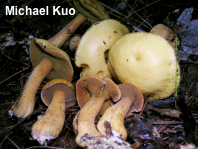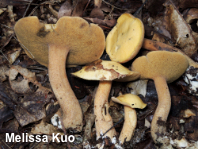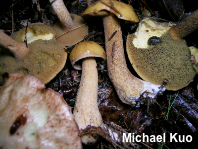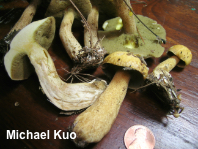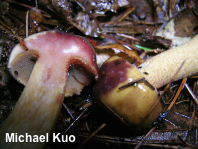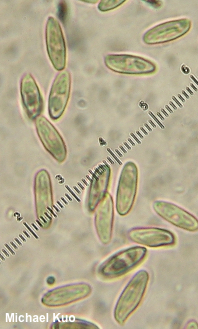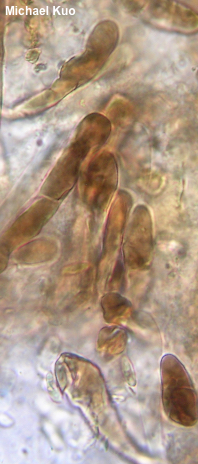| Major Groups > Boletes > Suillus > Suillus punctipes |

|
Suillus punctipes [ Basidiomycota > Boletales > Suillaceae > Suillus . . . ] by Michael Kuo This fairly easily identified Suillus is an associate of eastern white pine, and can be found throughout the natural range of the host tree (roughly, from Minnesota to Maine and the Carolinas). When young the species has a brown pore surface, and this feature serves as a good field character to separate it from similar mushrooms. The stem is densely covered with brownish glandular dots that darken with age, and the slimy cap is yellow when young, becoming pale yellow-brown. Western North America's Suillus tomentosus is probably the mushroom most similar in appearance to Suillus punctipes, but it appears under 2-needle pines on the other side of the continent, and the two species are not likely to be confused. Also similar is Europe's Suillus variegatus, associated with 2-needle pines. Description: Ecology: Mycorrhizal with eastern white pine; growing alone or gregariously; summer and fall; originally described from New York; distributed in Midwestern and northeastern North America, from Minnesota to Maine and the Carolinas. The illustrated and described collections are from Kentucky. Cap: 2.5–10 cm; convex, becoming broadly convex; sticky to slimy when fresh; dark yellow to orange-yellow when young, with a grayish to whitish belt of fuzz along the margin; becoming pale, dull yellow overall; bald at maturity. Pore Surface: Beginning to run down the stem; brown to orangish brown at first, becoming yellowish and finally olive; not bruising; with 1–2 round or angular pores per mm; radially arranged, but not strongly boletinoid; tubes under 1 cm deep. Stem: 5–10 cm long; 1–2 cm thick; equal or gradually thicker toward the base; densely covered with glandular dots that are pale brown at first and become darker brown or nearly black with age; whitish to yellowish or orangish under the glandular dots; without a ring; basal mycelium white or pastel orange. Flesh: Pale yellow to whitish overall; often orangish or reddish in the stem base; not staining on exposure. Odor and Taste: Odor strong and fragrant, or not distinctive; taste not distinctive. Chemical Reactions: Ammonia negative on cap; negative on flesh. KOH purple on cap; purple on flesh. Iron salts negative or gray on cap; grayish blue on flesh. Spore Print: Brown. Microscopic Features: Spores 7–10.5 x 2–3 µm; boletoid-fusiform; smooth; yellowish in KOH. Basidia 22–28 x 4–6 µm; clavate; 4-sterigmate. Hymenial cystidia in bundles; often poorly defined individually; 30–70 x 5–13 µm; cylindric, clavate, or fusiform; orange-brown to brown in KOH. Pileipellis an ixocutis; elements 2–5 wide, smooth, hyaline to yellow-brown KOH. REFERENCES: (C. H. Peck, 1878) R. Singer, 1945. (Coker & Beers, 1943; Singer, 1945; Smith & Thiers, 1964; Snell & Dick, 1970; Smith & Thiers, 1971; Grund & Harrison, 1976; Smith, Smith & Weber, 1981; Phillips, 1991/2005; Both, 1993; Bessette, Roody & Bessette, 2000; Roody, 2003; McNeil, 2006; Klofac, 2013; Kuo & Methven, 2014; Bessette et al., 2016; Nguyen et al., 2016; Baroni, 2017; Sturgeon, 2018; McKnight et al., 2021.) Herb. Kuo 10010403, 09241115, 10051510. This site contains no information about the edibility or toxicity of mushrooms. |
© MushroomExpert.Com |
|
Cite this page as: Kuo, M. (2022, May). Suillus punctipes. Retrieved from the MushroomExpert.Com Web site: http://www.mushroomexpert.com/suillus_punctipes.html |
